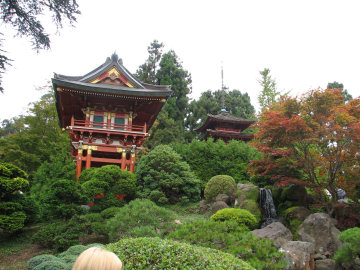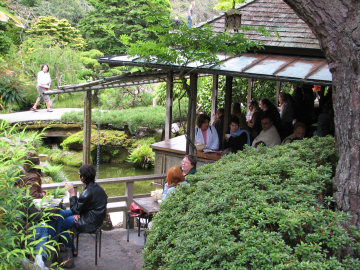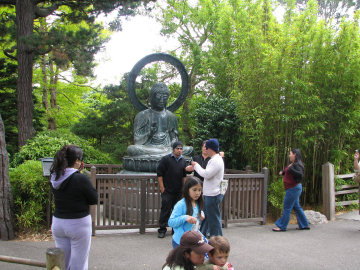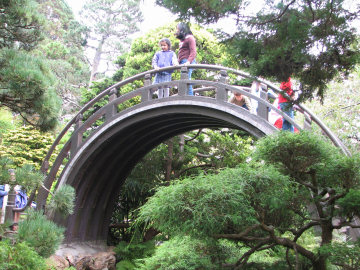|
Japanese Tea Garden San Francisco's Golden Gate Park  San Francisco's Japanese Tea Garden was originally developed for the 1894 World’s Fair in San Francisco. It was conceived and designed by
Baron Makoto Hagiwara, a wealthy landscape designer. As Golden Gate Park began to develop, Hagiwara worked the once temporary exhibit into a permanent feature.
Hagiwara and his family then increased the size of the gardens, and imported exotic animals and statues. The gardens were also influenced and portions developed by Master Shrine Builder Shinshichi Hagiwara’s descendents maintained the Japanese Tea Garden until the start of the second world war. At the time, America went to war with Japan, and had begun sending anyone of Japanese descent into temporary internment camps. Without the Hagiwara family, the Japanese Tea Garden was not kept and fell into ruin. During this time, it was renamed the Oriental Tea Garden. It was eventually reinstated as the Japanese Tea Garden in 1952, with more exhibits, including a 9,000 pound Lantern of Peace. It was in the Japanese Tea Garden where Fortune Cookies originated, and soon became increasingly popular. The Garden has now grown into a landmark of San Francisco’s Golden Gate Park.
Five Reasons to visit The Japanese Tea Garden 1. You can pretend that you’re in a Martial Arts Film. The Japanese Tea Gardens of Golden Gate Park were designed to have a very romanticized look of a traditional Japanese garden. As a result, entering the Garden is like stepping into the world that you see in Asian paintings. It is also bears a strong resemblance to the backgrounds of most Martial Arts movies. It made me wish that I had a samurai sword and a dozen ninjas were attacking me. 2. Tranquility Did you ever read The Secret Garden by Frances Hodgson Burnett? In that book, the main character Mary discovers a key that opens a door to a hidden garden. The Japanese Tea Garden is also a fenced-off world that exists both inside and outside the hustle and bustle of life. Like Mary, I was able to find temporary sanctuary from whatever problems I was facing and just enjoy a life filled with all things natural.  Unlike most San Francisco recreation areas, the Japanese Tea Garden is not teeming with loud tourists and useless guided tours. Hundreds of people can visit the Garden and still have some degree of personal space. Personally, I think there is something about this place that just takes the loudness out of people. It is a peaceful place, and there is a lot to see. About the only sound you hear are the cameras clicking. 3. Flora and Fauna Apparently, the Japanese believe that gardens are a high form of art. If that is true, then the “artist” of this garden chose an especially interesting medium of cherry trees, bonsai trees, and azaleas. Some of the bushes have been cut to make interesting forms, such as Mount Fuji and a dragon. This may sound like a tacky Disneylandish tactic to woo tourists into taking more pictures (and then pay expensive prices for film at the gift shop), but it doesn’t come off this way. Even though the Japanese Tea Garden needs full-time landscape maintenance, it is constructed to maintain a great degree of natural beauty. Not only do the gardens have such beautiful plants, but they also house many interesting animals as well. Every pond you pass (and there are many), you will find teeming with koi fish, and there are also many exotic birds. Consider a beautiful bouquet of flowers for your family when you return to your room after a beautiful day... 4. Fortune Cookies 
In case you don’t know, Fortune Cookies are about as Asian as spaghetti is Italian. Apparently, the builders of this garden, the Hagiwara family, first served them at the Japanese Tea Garden. You can still buy them at the Tea Shop, and I got one that read: “You were an idiot for believing that Fortune Cookies are from China”. Okay, I made that one up, but I think my lucky numbers were 4, 8, 15, 16, 23, 42, which are the pivotal numbers on the TV show Lost. Or I could just be an avid Lost fan. 5. The Drum Bridge  It’s called the Drum Bridge because it looks like someone cut a large drum in half and used it as a bridge. The end result is something that looks beautiful, terribly impractical. The slope of the bridge is so steep that you have to literally climb it. Fortunately, it has footholds on it, otherwise you would need a pair of cleats. Still, once you get up to the top, be sure to have someone take your picture. While you’re at it, waste your film on everything else as well. By: Mark Rollins, Copyright SFTRAVEL LLC |
